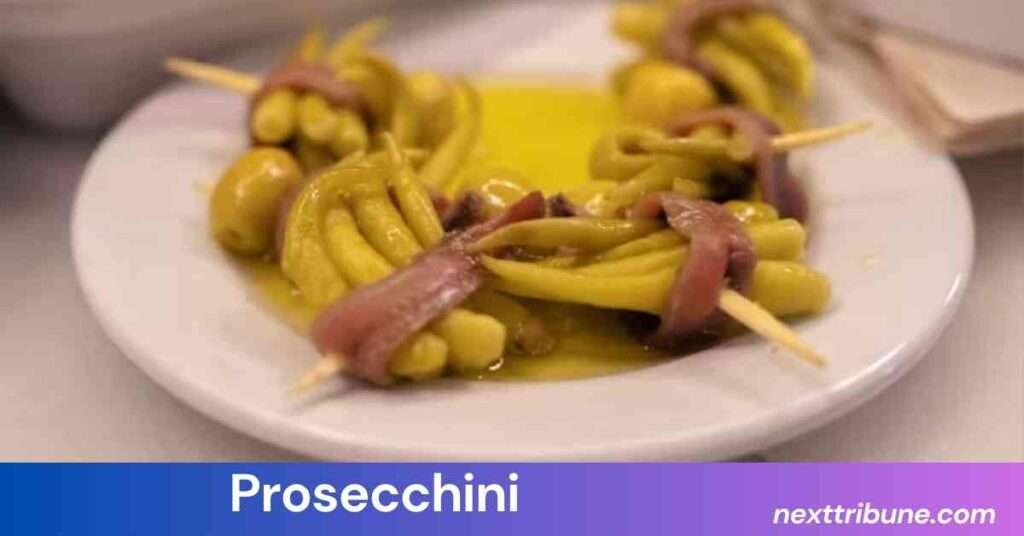
Prosecchini has emerged as a standout culinary phenomenon, making waves in kitchens, restaurants, and food blogs across the globe. This dish, though still somewhat new to the mainstream, is quickly becoming a favorite among food lovers for its unique flavors, versatility, and ability to complement a wide range of cuisines. Prosecchini has caught the attention of chefs, home cooks, and food critics alike, who are praising its delightful combination of textures and flavors.
But what exactly is Prosecchini? How did it come to be such a popular dish? And why is it quickly taking over food menus across the world? In this article, we will delve into the origins of Prosecchini, the ingredients that make it so special, its health benefits, and the various ways it’s being adapted in modern cuisine.
By the end of this article, you’ll understand why Prosecchini is more than just a passing trend—it’s a culinary sensation that has rightfully earned its place in kitchens everywhere.
The Origins of Prosecchini: A Delicious Heritage
To truly understand the significance of Prosecchini, it’s essential to explore its roots. The origins of Prosecchini can be traced back to Italy, where its creation draws inspiration from traditional Italian food culture. Much like many Italian dishes, Prosecchini embodies the essence of Italian cooking: simple yet sophisticated, bold in flavor but light in texture. However, Prosecchini is also a product of modern culinary experimentation and innovation.
In its early days, Prosecchini was likely a local, regional dish, shared among close-knit communities. Over time, as Italy’s cuisine gained global recognition, Prosecchini was embraced by chefs who saw its potential and began refining the recipe. The dish has since undergone many adaptations, taking on diverse forms based on regional ingredients, cooking methods, and cultural influences.
Though it started as a dish enjoyed mostly within Italy, Prosecchini’s flavors and versatility have made it an internationally recognized dish, one that is now featured in restaurants across the United States, Europe, and beyond.

How Prosecchini Is Made: A Step-by-Step Guide
Making Prosecchini is both an art and a science. The process combines traditional culinary techniques with modern twists to create a dish that’s as satisfying to the taste buds as it is to the eyes. Below is a step-by-step guide to making this dish at home.
Also Read: Aurö: The Meaning in Modern Digital Culture
Ingredients:
- Prosecco: This sparkling wine, often used in Italian cuisine, is a key ingredient in making Prosecchini. Its bubbles bring an effervescent touch to the dish and help balance the richness of the other ingredients.
- Fresh Vegetables: Prosecchini typically includes fresh vegetables such as zucchini, tomatoes, or bell peppers. These add color and nutrition to the dish.
- Cheese: Many versions of Prosecchini incorporate cheese, with Parmesan or Ricotta being common choices. The cheese adds creaminess and depth of flavor.
- Herbs and Spices: Fresh basil, garlic, and other Mediterranean herbs bring fragrance and zest to the dish.
- Olive Oil: A key element of Italian cooking, olive oil is used to sauté the vegetables and add richness to the dish.
Cooking Instructions:
- Prep the Vegetables: Wash and chop your chosen vegetables into bite-sized pieces. Depending on your preference, you can choose to roast, sauté, or grill them.
- Sauté with Olive Oil: Heat some olive oil in a pan, then sauté the vegetables along with garlic until they are soft and aromatic.
- Add the Prosecco: Once the vegetables are well-cooked, pour in a generous amount of Prosecco. Let it simmer until the alcohol evaporates, leaving behind the bubbles and flavor.
- Combine and Stir: Stir in your choice of cheese and allow it to melt into the vegetables, creating a rich and creamy texture.
- Garnish: Finally, sprinkle some fresh basil or other herbs over the dish to add a fresh and aromatic finish.
This basic version of Prosecchini can be customized further by adding proteins such as chicken or seafood, or adjusting the flavors with different spices. The beauty of Prosecchini lies in its versatility and the ability to make it your own.
The Flavors and Texture of Prosecchini: What Makes It Unique?
One of the key elements that make Prosecchini so appealing is its flavor and texture. The dish’s distinctiveness lies in its perfect balance of contrasting elements. The Prosecco gives the dish a light, effervescent quality, while the vegetables add freshness and crunch. The richness of the cheese balances out the acidity of the wine, creating a smooth, creamy texture that coats the vegetables.
Also Read: David Borhaz: A Journey of Persistence, Innovation, and Integrity
Each bite of Prosecchini offers a delightful combination of savory and sweet, with subtle notes of garlic and herbs that enhance the flavor. The overall effect is a comforting yet sophisticated dish that feels at once familiar and exciting.
Prosecchini is also customizable to suit a variety of tastes. For those who enjoy a stronger flavor, you can experiment with more robust cheeses or add a bit of heat with chili peppers. For a milder dish, you can opt for lighter vegetables and a touch of lemon for added freshness.
Prosecchini in Modern Cuisine: Popular Variations and Pairings
As Prosecchini gains popularity, chefs around the world have experimented with new variations of this Italian classic, adapting it to fit the tastes and trends of modern cuisine. Some chefs have incorporated non-traditional ingredients like quinoa, couscous, or mushrooms to provide a more diverse experience. Others have used Prosecchini as a base for more elaborate dishes, combining it with roasted meats, fresh salads, or risottos.
Popular Variations:
- Vegetarian Prosecchini: A completely plant-based version of Prosecchini that swaps cheese for cashew cream or vegan alternatives.
- Seafood Prosecchini: Incorporating seafood like shrimp or scallops, this variation enhances the flavor profile with a delicate marine taste.
- Prosecchini with a Twist: Some chefs have incorporated unconventional flavors, such as truffle oil or balsamic vinegar, to elevate the dish even further.
Pairing Prosecchini with Wines:
Prosecchini pairs beautifully with a variety of wines, thanks to its fresh and effervescent nature. A crisp white wine such as Pinot Grigio or Sauvignon Blanc complements the dish’s lighter flavors. If you prefer red wine, a light Pinot Noir or Merlot will work well.
Health Benefits of Prosecchini: A Guilt-Free Delight?
Prosecchini is not just a delicious and indulgent dish—it also offers several health benefits. Packed with fresh vegetables, herbs, and antioxidants, Prosecchini is a nutrient-dense dish that can be enjoyed without the guilt.
The Prosecco used in Prosecchini provides a moderate amount of antioxidants, which are known to help reduce inflammation and promote heart health. The vegetables, rich in vitamins and minerals, contribute to overall well-being, making Prosecchini a wholesome dish to enjoy.
Healthier Variations:
- Low-Calorie Prosecchini: For those watching their calorie intake, using lighter cheeses or substituting some of the heavier ingredients can make for a lower-calorie version of Prosecchini.
- Gluten-Free Option: By swapping out any gluten-containing ingredients and focusing on naturally gluten-free components like quinoa or rice, you can easily make Prosecchini gluten-free.
Prosecchini in Global Cuisine: A Worldwide Phenomenon
While Prosecchini originated in Italy, its universal appeal has led it to become a global sensation. From the bustling streets of New York City to the vibrant markets of Tokyo, Prosecchini is featured on menus around the world. Chefs and food lovers alike have embraced Prosecchini, experimenting with local ingredients and putting their own spin on the classic recipe.
In countries like the United States, Prosecchini has found a home in both upscale dining establishments and casual home kitchens. Its ability to adapt to different tastes and cultures has made it a go-to dish in many parts of the world.
Also Read: www.crypticstreet.com: Top Source for Tech, Gaming & Cryptocurrency News
Prosecchini: Frequently Asked Questions (FAQs)
What is the best wine to pair with Prosecchini?
Prosecchini pairs best with a crisp white wine like Pinot Grigio, Sauvignon Blanc, or a light red wine like Pinot Noir.
Can Prosecchini be made ahead of time?
Yes! Prosecchini can be prepared in advance and stored in the refrigerator for a day or two. Simply reheat it gently before serving.
Is Prosecchini gluten-free?
Prosecchini can easily be made gluten-free by substituting gluten-containing ingredients and focusing on naturally gluten-free components like quinoa or rice.
Conclusion: Why Prosecchini Deserves a Place in Your Kitchen
Prosecchini is not just a passing trend—it’s a dish that has truly made a mark on the culinary world. Whether you’re preparing it at home or enjoying it in a fine dining setting, Prosecchini offers something for everyone. With its rich history, diverse flavor profile, and endless versatility, it’s no surprise that this dish is quickly becoming a staple in kitchens worldwide.
Give Prosecchini a try, and let your taste buds discover why it has become the culinary sensation that food lovers everywhere are raving about.



